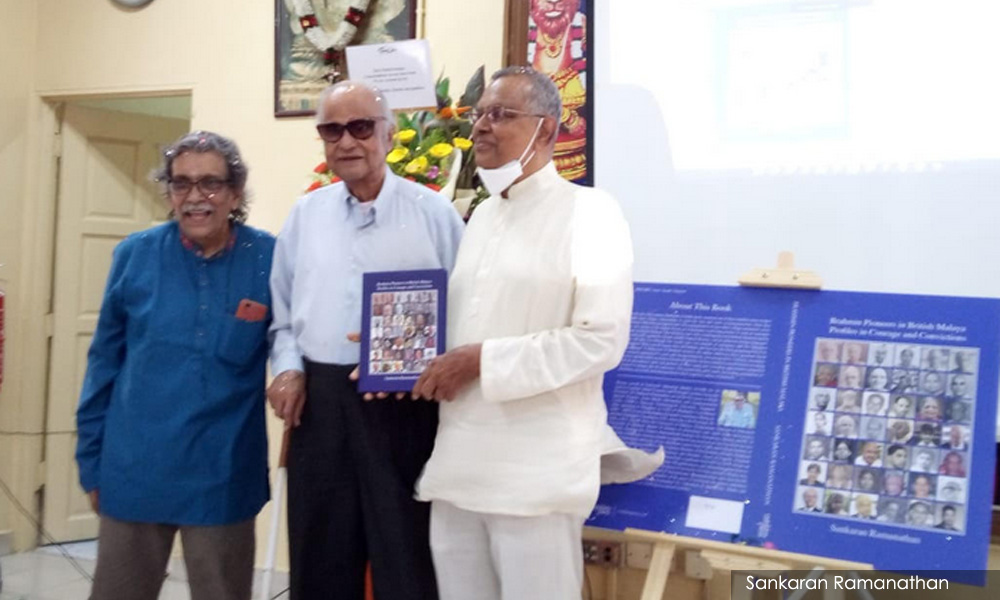Malaysia comprises many different communities that can be broken down by ethnicity, language, region and other interesting distinctions.
One of the smaller communities that still survive in Kuala Lumpur is the Tamil Brahmin community.
Like other groups within the broader Tamil community such as the Chettiars and the Thevars, the Brahmin community was based on strict intermarriage within the highest-ranking Hindu caste (social class).
Eventually in India in 1948, discrimination on the basis of caste was banned by law and this was enshrined in the Indian constitution, and in 21st century Malaysia, such traditional practices have largely died out.
Intermarriage, not just outside of caste lines but of race and religion too, is common.
Nonetheless, Prof Sankaran Ramanathan, 81, has just penned a book called ‘Brahmin Pioneers in British Malaya: Profiles in Courage and Convictions’, which details the journey of some of those who chose to move to the Malayan peninsula.

“In the late 19th century, Brahmins in India rarely ventured out of their tightly-knit village communities to cross the sea, settle in a distant land and risk ex-communication and ostracism when they returned to India.
“What then prompted some 130-odd young pioneers to venture into the unknown, persevere and become successful in an unfamiliar environment?
“How did they uphold and perpetuate cultural and religious traditions and pass these on to succeeding generations and what was the legacy they left behind?” asked Sankaran in a short address at his book launch on Sunday.
Succeeding despite the odds
Sankaran’s grandfather, Sermadevi Sivaramakrishna Sankaranarayana Iyer (SSS Iyer), was one of the pioneer batches of migrants who moved to British Malaya in the late 1890s and his journey is documented in the book.
Many pioneer Brahmins had to adapt to the secular and worldly needs of serving clerical roles in the British Empire - SSS Iyer was a postmaster in Banting and his son, S Ramanathan, Iyer was a court interpreter.
At the same time, there were prayer rituals, community gatherings and a strict vegetarian diet to adhere to, said Sankaran.
“This book was conceived six years ago as a simple account of the Brahmin community. Along the way, it morphed into more of a collection of mini-biographies as more descendants wanted to tell their own stories.
“So I changed its focus and there are 60-plus profiles of these pioneers. They came to an unknown environment far removed from the traditional villages they left behind and succeeded,” he said.
The 300-page book begins with a concise socio-economic history of British Malaya, World War Two and the Japanese Occupation, independence and Singapore separation.
Its core consists of profiles of about 70 pioneers, priests and music gurus, many of which are contributed by their descendants.
Among the better known Malaysian Brahmins include the late former Malaysian Airlines (MAS) chairperson Rama Iyer and prominent lawyer and human rights advocate Ambiga Sreenevasan, one of eight recipients of the US International Women of Courage Award in 2009.
“Each profile is a mini-biography and tells its own story. The book shows that Brahmin pioneers left behind proud and lasting legacies for succeeding generations to follow,” Sankaran said.
A former associate professor with University Teknologi Mara, Sankaran has penned or co-authored a number of books including such as ‘Media, Democracy & Civil Society’ (2013) and ‘Affirmative Action in Malaysia: Paradigm Shifts in Higher Education’ which was co-authored with his former student, right-wing politician Ibrahim Ali. - Mkini




No comments:
Post a Comment
Note: Only a member of this blog may post a comment.